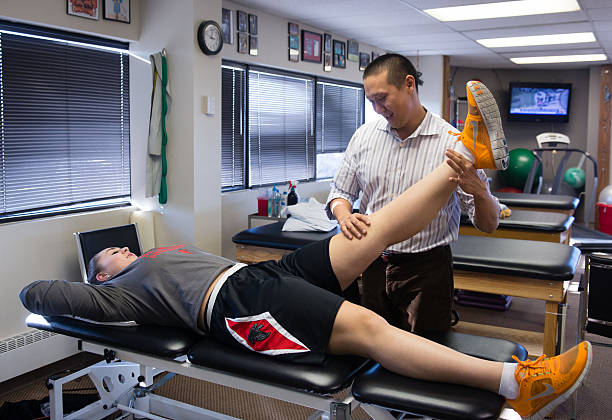An ACL injury can be a devastating experience for anyone. Such an injury can impact their mobility and hinder their ability to perform everyday activities. In this article, we’ll discuss what an ACL injury is, how it occurs, and most importantly, what preventative measures you can take to reduce the risk of injury.
What is an ACL Injury?
The Anterior Cruciate Ligament, or ACL, is a ligament that connects the thigh bone to the shin bone. It is one of the four major ligaments in the knee joint and is responsible for providing stability to the knee joint – specifically, to prevent your tibia (shin bone) from moving anteriorly, relative to your femur (thigh bone). An ACL injury can either be a tear or sprain to this ligament, which can occur due to various reasons such as a sudden change in direction, twisting of the knee, or landing from a jump.
How Does an ACL Injury Occur?
ACL injuries are common in sports involving sudden stops and direction changes, such as basketball, football, and soccer. They can also occur in non-contact sports such as skiing and gymnastics. The injury often occurs due to a sudden change in direction, landing awkwardly from a jump, or a collision with another player. The common mechanism of injury is when the knee performs or is put in a situation where the following 3 compromising movements occur simultaneously – Knee flexion (bend), knee valgus (caves in), and tibial external rotation (shin bone turns out), while the foot is planted.
Preventative Measures for ACL Injuries
Preventing ACL injuries starts with understanding what causes them and taking steps to avoid those situations. Here are some preventative measures you can take to reduce the risk of ACL injury:
- Proper Warm-up and Stretching
One of the most important things you can do to prevent ACL injuries is to warm up properly before any physical activity. This should include dynamic stretching and functional warm-up exercises that target the muscles around the knees, hips, core, and ankles. Ideally, those warm-up exercises should include sport-specific movements, eg. cutting drills, fire-steps, agility ladder footwork, and acceleration-deceleration drills.
- Strengthening Exercises
Incorporating strengthening exercises into your workout routine can also help prevent ACL injuries. Exercises that focus on building strength in the legs, such as squats and lunges, can help improve stability and reduce the risk of injury.
- Proper Footwear and Equipment
Wearing proper footwear and equipment may help prevent ACL injuries. Shoes with good traction and support can help prevent slips and falls, while knee braces may offer additional support to the knee joint.
- Correct Landing Technique
Proper landing technique is crucial in preventing ACL injuries. When landing from a jump, it is important that neither knee is allowed to forcefully cave in.
However, in game situations are never ideal and many environmental factors make it hard for us to predict exactly what could happen. Consequently, it is prudent to also learn or visualise how to perform a safety crash/ roll onto the floor from an awkward landing so as to offload a vigorous and uncontrollable momemtum that you may find yourself in.
- Preparing Oneself Physically, Skill-wise, and Psychologically for High-Risk Situations
Preparing yourself through skills training, proprioceptive training, and visualization exercises of high-risk situations, such as sudden stops and changes in direction, can also help prevent ACL injuries. If you’re participating in a sport involving risky movements, practice them carefully and with proper technique.
In conclusion, ACL injuries can be devastating, but they can also be prevented. By taking the necessary preventative measures, you can reduce the risk of ACL injuries and enjoy your favorite sports and activities without constant fear or hyper-vigilance of injury. Remember to warm up properly, incorporate appropriate exercises, consider wearing proper footwear and equipment, practice proper landing techniques, and prepare for high-risk situations. Stay safe and keep moving!
How long does it take until I can run again?
The first step in recovering from an ACL injury is to see a doctor or a physiotherapist. They will evaluate your injury and recommend the best course of treatment. In some cases, surgery may be necessary to repair or replace the torn ligament. After surgery, you will require adequate rest, complemented with some easy lower limb exercises as instructed by your physiotherapists to facilitate proper knee recovery.
Once you have healed from surgery, you will begin physical therapy. This is an essential part of the recovery process, as it will help you regain strength, flexibility, and range of motion in your knee. Your physiotherapist will guide you through exercises that will gradually increase in intensity over time. You may also use braces or crutches to protect your knee and aid your ambulatory ability.
Returning to running after an ACL injury requires patience, perseverance, evaluations and reassessments, and proper guidance. It’s important to follow your physiotherapist’s instructions and not rush the process. Depending on the severity of your injury, it may take 12 or more weeks* before you can start running again.
The key to a successful recovery is to be prudent and disciplined with doing your exercises. Start with simple exercises like walking and cycling, and gradually increase the intensity and duration of your workouts. Your physiotherapist will monitor your progress and adjust your treatment plan accordingly.
It’s also important to maintain a healthy diet and lifestyle during your recovery. Eat a balanced diet that includes plenty of protein, vitamins, and minerals to give what your body needs to heal. Avoid smoking and excessive alcohol consumption, as these can slow down the healing process.
In summary, returning to running after an ACL injury can take time, but it’s possible with proper treatment and rehabilitation. Be patient, follow your physiotherapist’s instructions, and take care of your body through adequate rest, exercising discipline, and proper nutrition. With time and effort, you can get back to doing what you love.
E-mail: appointments@hongkongsportsclinic.com
Phone: +(852) 3709 2846
Instagram: @hongkongsportsclinic
(https://www.instagram.com/hongkongsportsclinic?igsh=bzh5bHlzZzJobW9q&utm_sour ce=qr)


